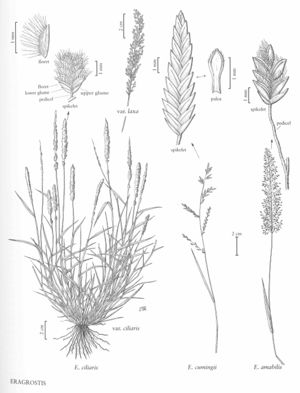Eragrostis amabilis
Plants annual; cespitose, without innovations, without glands. Culms 5-40 cm, erect, glabrous, occasionally with oblong glandular areas below the nodes. Sheaths hairy on the distal margins and at the apices, hairs to 4 mm, stiff; ligules 0.2-0.3 mm; blades 2-8 cm long, 2-4 mm wide, flat to involute, abaxial surfaces smooth, adaxial surfaces scabridulous, bases occasionally with papillose-based hairs. Panicles 4-15 cm long, 1-7 cm wide, cylindrical to narrowly ovate, open, rachises sometimes glandular below the nodes; primary branches 0.5-4 cm, diverging 20-100° from the rachises; pulvini sparsely pilose; pedicels 1-4 (7) mm, as long as or longer than the spikelets, mostly pendent, lax, terete. Spikelets (1) 1.5-2.5 mm long, 0.9-1.4 mm wide, ovate to oblong, reddish-purple to greenish, with 4-8 florets; disarticulation basipetal, glumes persistent. Glumes ovate, hyaline, keeled, veins commonly green; lower glumes 0.4-0.7 mm; upper glumes 0.7-1 mm; lemmas 0.7-1.1 mm, ovate to broadly oblong, membranous, lateral-veins usually greenish, apices truncate to obtuse; paleas 0.6-1.1 mm, hyaline, keels ciliate, cilia 0.3-0.5 mm, apices obtuse to truncate; anthers 3, about 0.2 mm, purplish. Caryopses 0.3-0.5 mm, ellipsoid, translucent, light-brown. 2n = 20.
Distribution
Puerto Rico, Ga., Tex., Virgin Islands, Pacific Islands (Hawaii), Miss., S.C., Ala., Fla.
Discussion
Eragrostis amabilis is native to the Eastern Hemisphere. It is now naturalized in the southeastern United States, growing in open areas such as cultivated fields, forest margins, and roadsides at 0-200 m.
Selected References
None.
Lower Taxa
"decumbent" is not a number.
